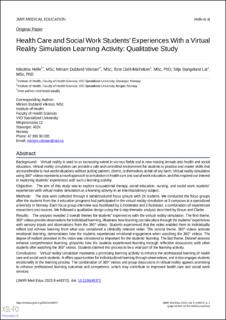| dc.contributor.author | Helle, Nikolina | |
| dc.contributor.author | Dahl-Michelsen, Tone | |
| dc.contributor.author | Lie, Silje Stangeland | |
| dc.contributor.author | Vikman, Miriam Dubland | |
| dc.date.accessioned | 2024-04-10T12:21:53Z | |
| dc.date.available | 2024-04-10T12:21:53Z | |
| dc.date.created | 2023-09-21T14:48:25Z | |
| dc.date.issued | 2023 | |
| dc.identifier.citation | Helle N, Vikman MD, Dahl-Michelsen T, Lie SS Health Care and Social Work Students’ Experiences With a Virtual Reality Simulation Learning Activity: Qualitative Study JMIR Med Educ 2023;9:e49372 | en_US |
| dc.identifier.issn | 2369-3762 | |
| dc.identifier.uri | https://hdl.handle.net/11250/3125817 | |
| dc.description.abstract | Background: Virtual reality is used to an increasing extent in various fields and is now making inroads into health and social education. Virtual reality simulation can provide a safe and controlled environment for students to practice and master skills that are transferable to real-world situations without putting patients, clients, or themselves at risk of any harm. Virtual reality simulation using 360° videos represents a novel approach to simulation in health care and social work education, and this inspired our interest in exploring students’ experiences with such a learning activity.
Objective: The aim of this study was to explore occupational therapy, social education, nursing, and social work students’ experiences with virtual reality simulation as a learning activity in an interdisciplinary subject.
Methods: The data were collected through 6 semi structured focus groups with 28 students. We conducted the focus groups after the students from the 4 education programs had participated in the virtual reality simulation at 3 campuses at a specialized university in Norway. Each focus group interview was facilitated by 1 moderator and 1 facilitator, a combination of experienced researchers and novices. We followed a qualitative design using the 6-step thematic analysis described by Braun and Clarke.
Results: The analysis revealed 3 overall themes for students’ experiences with the virtual reality simulation. The first theme, 360° videos provide observations for individual learning, illustrates how learning can take place through the students’ experiences with sensory inputs and observations from the 360° videos. Students experienced that the video enabled them to individually reflect and achieve learning from what was considered a clinically relevant video. The second theme, 360° videos activate emotional learning, demonstrates how the students experienced emotional engagement when watching the 360° videos. The degree of realism provided in the video was considered as important for the students’ learning. The last theme, debrief sessions enhance comprehensive learning, pinpoints how the students experienced learning through reflective discussions with other students after watching the 360° videos. Students claimed this process to be a vital part of the learning activity.
Conclusions: Virtual reality simulation represents a promising learning activity to enhance the professional learning of health care and social work students. It offers opportunities for individualized learning through observations, and it also engages students emotionally in the learning process. The combination of 360° videos and group discussions in virtual reality appears promising to enhance professional learning outcomes and competence, which may contribute to improved health care and social work services. | en_US |
| dc.language.iso | eng | en_US |
| dc.publisher | JMIR Publications | en_US |
| dc.rights | Navngivelse 4.0 Internasjonal | * |
| dc.rights.uri | http://creativecommons.org/licenses/by/4.0/deed.no | * |
| dc.subject | social work | en_US |
| dc.subject | health care | en_US |
| dc.subject | higher education | en_US |
| dc.subject | health care and social work | en_US |
| dc.subject | experiences | en_US |
| dc.subject | learning | en_US |
| dc.subject | virtual reality simulation | en_US |
| dc.subject | virtual reality | en_US |
| dc.title | Health care and social work students’ experiences with a virtual reality simulation learning activity: Qualitative study | en_US |
| dc.type | Peer reviewed | en_US |
| dc.type | Journal article | en_US |
| dc.description.version | publishedVersion | en_US |
| dc.rights.holder | ©Nikolina Helle, Miriam Dubland Vikman, Tone Dahl-Michelsen, Silje Stangeland Lie. Originally published in JMIR Medical Education (https://mededu.jmir.org), 20.09.2023. | en_US |
| dc.source.pagenumber | 1-12 | en_US |
| dc.source.volume | 9 | en_US |
| dc.source.journal | JMIR Medical Education | en_US |
| dc.identifier.doi | 10.2196/49372 | |
| dc.identifier.cristin | 2177636 | |
| cristin.ispublished | true | |
| cristin.fulltext | original | |
| cristin.qualitycode | 1 | |

